Today’s article is a guest post by Seth Cane, on the development of the Galil ARM…
The Galil ARM
by Seth Cane
The Galil rifle began life in the late 1960’s. The Six Day War of 1967 made apparent the need for a more rugged, versatile and low-maintenance service rifle to the IDF after experiences with the locally-produced FN FAL proved less than satisfactory. A request was put out for a new service rifle that could survive the arid desert conditions of Israel.
The initial Galil design has been accredited over the years as being a direct-copy of the Finnish Valmet rifle series, but this is not quite accurate. The first Galil prototypes began as simple modifications of captured Soviet AK-47s by Yisrael Galili, which included a number of features later implemented into the final design. Dubbed the Balashnikov, these included a modified fire-selector for use with the shooter’s thumb or fingers while holding the grip; a bipod mounted directly on the gas block; a modified/enlarged handguard to accommodate sustained fire and the bipod when in the folded position, and a folding stock.
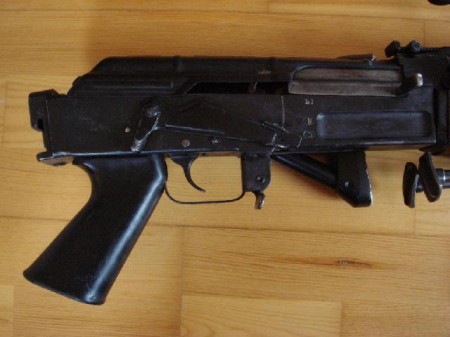
The model pictured above is built on either a Type II or Type III AK-47. Uziel Gal (creator of the Uzi) designed his own prototype service-rifle replacements in 5.56 and 7.62 NATO (seen above the Balashnikov in the photo below).
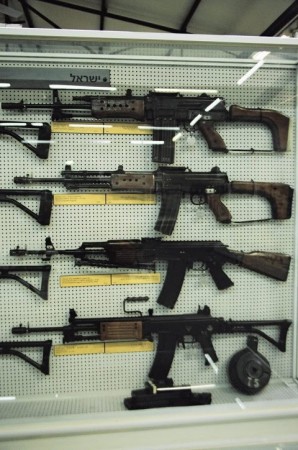
The Balashnikov won out against the American M16 and Stoner, the Russian AK47, and the German HK33. Yisrael Galili’s Balashnikov would eventually be further altered into what became the Galil. The initial production version of the Galil had taken a number design features directly from the Finnish Valmet, most notable being the Gas Block and Rear-Sight assemblies with night-sight provisions. The Galil receiver was also directly copied off the Valmet; popular rumor has been that the first Galil rifles to leave the IMI factory used blank Valmet receivers before production was started in-house, though no evidence has yet come forth to confirm this.
Galil ARMs were first adopted by the IDF in 1972, though few were distributed by the breakout of the Yom-Kippur war of 1973. The Galil ARM (and all other variations) would see most use during the 1982 Lebanon Conflict where it served as the primary service-rifle alongside the Galil SAR. Although having fully-adopted the Galil series, the IDF would continue to issue M16 rifles in support roles due to it’s lighter weight. By the late 1990’s and early 2000’s, the Galil was largely replaced by American M16s and M4 Carbines, though the Galil SAR remains popular amongst armored vehicle crews because of it’s compact size.
Of the three variations initially produced, the ARM(Assault Rifle and Machine-Gun) is arguably the most well-known. The ARM was designed to fulfill all the basic needs IDF infantryman, being capable of sustained accurate fire while also being capable of functioning well in Close-quarters combat situations. Each ARM was equipped with an integrated folding bipod and wire cutter, a carry-handle assembly with integrated bottle-opener, and an enlarged handguard capable of storing the bipod when folded. The model adopted by the IDF used a Teak-wood handguard (versus Polymer/plastic which would presumably overheat and melt faster) with no provision for mounting bayonets. Soldiers issued the ARM would often remove the carry-handle to reduce the overall weight and noise, and also occasionally remove the bipod assembly when on patrols. Later models of the ARM removed the carry-handle entirely, and update the bipod for a quick-detach model for this purpose. While initially intended to use the 50-Round Steel magazines for suppressive fire-roles, the ARM most often used the standard 35-Round Steel magazines as it was never fully-employed as a light-machine gun in Israeli service.

Although the ARM did not find widespread affection from the Israelis, it would become popular with countries like Guatemala and Colombia who purchased large numbers of them alongside AR and SAR models, and South Africa who would purchase and later produce a modified Galil ARM dubbed the R4. Usage of the ARM both as a light-machine gun (with 50-Round magazines) and as a DMR was more common overseas in Latin America and Africa. Estonia would also employ the ARM in various infantry roles alongside the AR and SAR, while Portugal would purchase a small-number of ARMs for usage with their paratroopers.

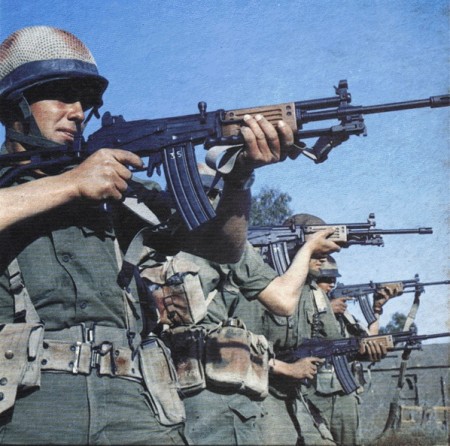
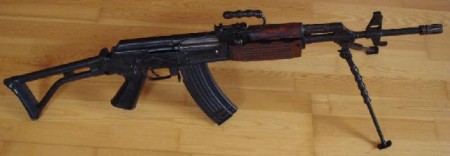
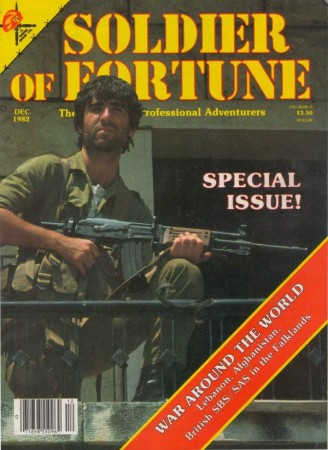
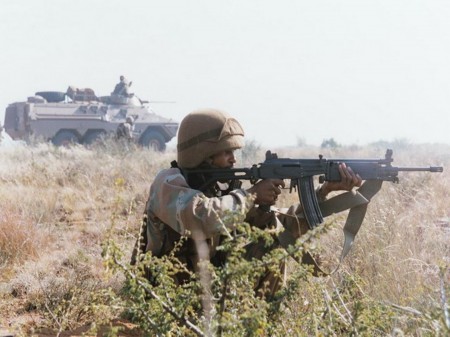
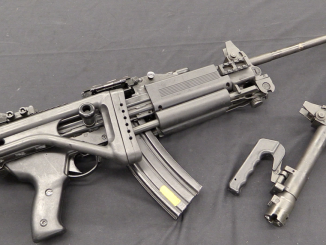
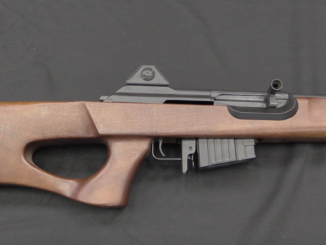
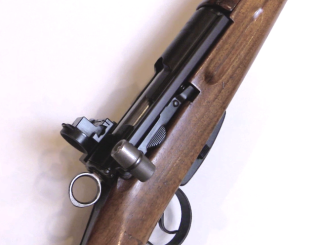
Your last photo is a photo of a South African soldier with R4 and not Portuguese
Pssst put an extra L in “Gail”. Apart from that, thanks for the article. If it has a thumb fire selector, why does it also have the AK style fire selector?
Why not? now you have a fire selector on both sides…
It blocks the slot for the charging handle when the gun is on safe, preventing the ingress of dirt and such.
I’m afraid the soldier in the last picture rather can’t be Portuguese, for in the background a Ratel 20 IFV may be seen and Portugal doesn’t have any of them.
Piotr
Could be a joint exercise
No, as Dawie Smit pointed out in the first post, that man isn’t a Portuguese soldier, and the rifle is of course an R4.
Interesting article. In the 1980s the Australian Defence Forces trialled the Galil alongside a host of other rifles. Curious that it came third – apparently it was let down by its accuracy. Fist place went to the M16a2 and second with the AUG. Colt refused to grand ADI the license to manufacture the M16 at Lithgow thinking that the Australians would let them manufacture in the states. The ADF went with the Steyr instead.
Anyway – long winded intro to my question. Has anyone else heard about issues with the accuracy of the Galil? Was it really that bad in the accuracy department or is it only when lined up against an inherently accurate platform like the M16?
The AK platform/bolt lock up is inherently not as accurate as some other rifles. The manufacturing tolerances are such that the slop prevents a solid lock up and the vibration induced when it fires prevents gilt edge accuracy!
This is not a problem in an Assault Rifle in that virtually 100% of the shots fired will be to keep other guys heads down.
On the other side of the scale, the M-16’s bolt lock up is very tight and strong leading to minimal vibration of firing. Then the lack of a gas piston further minimizes vibrations and makes it the most accurate individual weapon in general issue in the history of the world! Everything else was in a distant second place!
Given the two facts above, it is no wonder why the Stoner system has been so widely copied.
I know it’s an old comment, but it’s so high on BS I had to make an answer.
Firstly, I’m 100 % sure that the M-16 is not the most acurate weapon, most bolt actions are way more acurate.
Second, the Stoner system is not widely copied, in fact basically no other weapon uses it.
Accuracy of the .223 ARM was acceptable, but for some reason the .308 “Galil Sniper” had consistency problems (i.e., a “wandering zero”).
One fix I’ve heard of for this is to rebuild the gas block assembly so that it isn’t actually “anchored” to the barrel; rather, its connection forms a “sleeve” around the barrel, with the barrel free to vibrate at its natural resonance within it. With the barrel properly secured to the receiver, this gives an effect similar to a true “free-floated” barrel; Also, it prevents vertical group stringing due to upward pressure on the barrel from the bipod when fired off same.
Probably the best solution would be to mount the bipod to a forward extension of the forearm, in effect a cantilever anchored to the receiver. This would isolate the barrel entirely, resulting in an arrangement similar to that of the Walther 2000.
It would also probably increase the unit cost a good bit.
cheers
eon
The galil is meant to put as much lead in the sir as possible, still ( in my opinion) the biggest bang in fire suppression and intimidation that you can bring to a surprise party. Although with the magazines … very heavy
Do we know what the absolute accuracy figures were for the contestants and how they compare with say the 4 MOA acceptance for the SMLE?
Certainly an AK platform has lower intrinsic accuracy than say an AR
(the gas piston set up of the ak tends to bend the barrel downwards – compared to negligable effects of the AR gas tube, and the rear sight on the receiver top cover provides a less rigid and consistent relationship to the barrel than the AR top half which is rigidly connected to the barrel)
Though whether that results in absolutely unacceptable accuracy or merely a comparativley lower level of accuracy is an interesting question
There is no practical difference in AK and M16 accuracy for 99% of soldiers in 99% of combat situations.
The maximum group size in acceptance testing of American rifles since the M-14 is and has been just under 2.5 MOA! (2.39 MOA!) The M-16 does this with ease and many, more than half, will shoot into less than 1.6 MOA. ( Some will shoot into about 3/4 MOA!)
I had heard that the fail figure of the SMLE and SLR rifles was 4.5 MOA, not 4.0 MOA. Please tell me where you found this figure. I got mine from the BAoR in Germany in the ’70s numerous times in Inter sister unit matches where they complained that we were using “Match rifles, not typical Arms room weapons, as if they had not hand selected their weapons from numerous examples? (We got the same complaints from the Germans, Italians, Austrians, Sweed’s and everybody else we shot against!)
The Germans got so PO’d that we invited their team to come to our base and select the rifles we would use in the next match! We kicked their tails all the way back to Stuttgart!
You are probably correct on the 4.5″, I was going from memory. Handbook of small arms IIRC.
Hi Keith
I am not sure how this will help, but I can offer some observations as collected in time thru variety of sources.
1. Relative accuracy of AK and AR weapons expressed in MOA in about 2/1. If this if true (and many videos from ranges are indicative of that) it still does make AK “less accurate” that AR in practical sense; simply because these tests are performed under nearly ideal conditions.
2. Military issue rifles being a compromised solution (mainly for weight purposes) are extremely flex-prone during firing, namely in full auto. There is plenty of slow-motion wizardry to prove that. Further, there are ‘details’ as for instance on AR platform which are hurting otherwise pre-existing accuracy potential. Main contributors – just to pick few is mounting of hanguards movement versus barrel, movement of upper versus lower receivers and so on. On many sporting versions this is taken care of.
3. On weapon such as SMLE I’s expect something like .75-1.5 MOA with trained operator; similar on other bolt action rifles in original military tune. But at the end, there are as you may know, other factors and many are really hard to control, such as combat stress, light conditions, atmospheric conditions and so forth.
Great article Seth and a very interesting topic however unfortunately not well documented.
A few things I would like to add regarding the development of the Galil.
Along with the receivers being made by Valmet, it is also often said that the prototypes were fitted with M16 barrels. While this may (or not) have been true at some point, I can only attest that the one example I have in my collection has an israeli made 5.56 barrel screwed in a 1959 Soviet Type-III AK receiver. The barrel is threaded to accept a M16A1 flash hider.
Besides several external features such as a prototype ARM wooden handguard, that prototype has 3 major internal modifications:
– 5.56 ejector serial numbered to the rifle and welded to the receiver (the original ejector was removed by cutting it from the receiver)
– Modified trigger group, fitted with an israeli trigger
– The 5.56 bolt features a spring loaded firing pin
About the Balashnikov name, it is not clear to me if that was a nickname or the designers actual name. From what I’ve been able to gather and translate from an israeli forum, the designers may have been born Balashnikov, later changing his name to Galili due to the region he originated from.
My prototype is actually marked “Balashnikov” in hebrew in the left side, near the added thumb safety, along with “5.56” and the letter “M” in a circle.
I’ve also had the opportunity to examinate a very early and less evolved prototype, still chambered in 7.62 but already fitted with an israeli folding stock a Galil-like pistol grip. It also featured a FAL pistol grip fitted under the barrel to act a forward handgrip. It was built on a 1951 Soviet Type-II AK.
I’ve also read that there were a few thousand Galils made in .30 carbine for police/ urban combat situations. Used the standard M1 magazines but they seem to have had a problem with overheating, for some reason.
The Galil certainly found widespread acceptance in Columbia… I’ve seen pictures of it and read accounts (mostly by DEA agents) of the Galil being used by all three sides (government, lefty rebels, and right-wing paramilitaries) as well as commercial enterprises like the cartels. Never could find out for sure if the ones that wound up in Columbia (varying sources differ) were Galils or R4s.
The Colombian marines I saw in the city of Cartagena de Indias had 7.62x51mm Galil rifles. This larger-caliber version is widely used in that nation by the armed forces and the FARC-EP guerrillas you mentioned.
Guatemala had 5.56mm Galil rifles, as did Anastasio Somoza’s Guardia Nacional after the 1978 arms cut-off from the U.S. The state police in Jalisco were carrying Galils when I was last there some years ago. Galils also turn up in Haiti and elsewhere.
The Israeli Galil ACE is sold like hotcakes throughout Central and South America: El Salvador, Perú, etc.
The Colombians now build their own Galil copies (licenced, I suppose) both in 5.56mm and 7.62x51mm.
well its time to shine cristian…
Im from colombia, the Galil assault rifle is by far the most common firearm in the streets, almost every police officer is armed with one so you see them in a dialy basis, INDUMIL (colombian military industries) produces a licenced copy of the rifle and also sells it to other countries like peru and guatemala.
the rifle has seen a lot, and i mean a lot of combat in the colombian conflict, it is used by every side, police, army, navy, airforce, guerillas and paramilitary groups to the point im pretty sure almost one of every three deaths during the las 20 years of conflict were produced by round fired by a galil assault rifle, so it is not by any means a forgotten weapon, the rifle itself has seen mucho more combat than the AUG or even the M14.
In fact, its quite probable that while im writing this some one is killing someone with a galil and at least two dozen galils are bieng fired in combat, and im not exagerating, with two or three small scale confrontation betwen the goverment forces and the rebels per day and all of them using the galil there is no rational way to underestimate the usage of the rifle.
And shine you did, Christian. Great info (both in the above comment and the ones below) and poignantly told. You have a fascinating homeland… one I’ve been interested in for 25 years since a spell dating an affluent refugee (sent to Texas as a teenager because her prominent family feared she might be a target of kidnapping) and the stories she told me about Columbia made it sound wonderful, aside from the violence. (I’m a fanatical gardener and high altitudes near the equator make for an incredible year-round climate… she said that her hometown of Cali is pretty much high of 85 (Farenheight) and low of 60 year round with frequent rain, which trumps anywhere I’ve ever horticultured. And my experience with a Columbian woman – aside from being nuts, which is about average for me – is a fond and funny memory.)
While it is a country most norteamericans know little about beyond vauge stereotypes, Houston was lucky for many years to have an outstanding reporter named John Otis based there. If you bought the Sunday paper and there was one of his long stories from Bogata or out in the bush, you had gotten your money’s worth. After getting caught up in the massive downsizing of print journalism John wrote an outstanding book about Columbia:
http://www.amazon.com/Law-Jungle-Colombian-Guerrillas-American/dp/B006QS3958
that gets into a lot of background information that would probably be news to most non-Columbians. John is still is Columbia and is doing frequent radio reports for NPR/ PRI and it seems like I have heard him on the BBC a couple of times as well.
As I cannot back it by hard fact, I’d call it a rumor for most part, but Galil was not in spite of its pedigree a successful rifle. One reason might have been its excessive weight. I have examined the gun at more than one occasion myself and found it quite rugged – but indeed uncommonly heavy to fit in rifle role.
When trying to recall various newsreels and shots from action I remember they disappeared from IDF service rather quickly and were replaced by donated M16s and M4s. On the other hand the article quite correctly states that they found substantial service use in Columbia as was with the R4 in SAE. One could conclude therefore that rifle’s base was not bad.
The ‘nickname’ Balashnikov is interesting subject on its own. It is more than likely that the creator was of Russian background. As it became common with many Izraeli citizens, they adopted upon resettlement Hebrew names. One such case in this field is notoriously known Uziel Gall, born as Gotthard Glasse in Jena, Germany.
I suspect that the fate of the Galil in Israeli service and its replacement with the AR platform, might be the same as the fate of the ham and pea soup at the old age pensioner’s dinner:
“Mr Cohen, you can’t eat that, it’s not kosher!”
“It’s better than Kosher Mrs Jackson, it’s free.”
Hey Keith, where are you going for these jokes…))))
Seriously now, they just did not like the gun, I know it from close enough source.
On the other hand, they used ARs with s special sense of humor. As you may know there is this ‘highly practical’ cotter pin which secures firing pin. When the cotter pin was lost, there was no-way out of base on Saturday night, big inconvenience for many Israelis. So they decided to call it “Saturday night pin”. They are people of humour, you know.
… but thats just one part of the story…
the rifle, although widely used, its considered to be a low class weapon compared to the AKM and the M16 derivates, i have spoken with a lot of members of the military forces who portray the rifle as heavy, cumbersome, uncontrolable, unconfortable and unnacurated.
the praise the AKM/AK 47 for its caliber and stoping power, and the AR platform for its accuracy, ligth weigth and what they call “maniobrability” a police once told me it was kinda hard to get a fast sigth picture with his Galil so he ended up aiming with the front sigth wich affected his efective range and increased his ammo consumption, when he recieved a m16a2 he was more than suprised with the handling characteristics of the rifle, he was amazed when he discovered how easily the sigths aligned, he used the rifle with great effect to repeal guerilla attacks on two towns until his unit was abushed he got captured and eventually released… without his beloved rifle of course.
in fact AR derivates are highly pised by guerilla commanders and special forces, second tier combatants are usually armed with 7,62 battle rifles and AKM rifles while lower class rebels recieve colombian made galil rifles, shotguns or rifles in bad shape (i heard some norinco made M16s ended up in the hands of low tier rebels due to is terrific reliability).
and thats another point, colombian made Galil rifles have a bad reputation, many say they are way to unreliable for jungle warfare… that said in a place where there is little complaint about the reliability of M16 derivates and old M60 lmgs its quite a critic.
The problems with the galil were so obvious that it is actually being replaced by the modernized galil ACE wich is also locally produced and thus far has shown to be much better than its predecesor. thats why most police officers use one, if you have a bunch of assault rifles laying around you can pretty much issue them to second line troops like urban police officers wich rigth now rarely use them in patrol and rely more on sig sauer 9mm pistols with are much ligther and adequated for urban LE operations.
well thanks for reading, i have a lot of information about small arms usage in the colombian conflict if anyone is interested it would be a pleasure to share all this information… by the way sorry for the mediocre usege of english lenguaje…
Excellent reading Cristian, please keep going (pending Editor’s approval of course)! Your English use, as far as I can tell is superb.
I am in particular interested in success/ failure of different designs of firearms in South American subcontinent.
Cristian – One that I’ve always been curious about… I’ve retained an amazing amount of information from the ads for Century Arms and other surplus dealers that were in a stack of old pre-68 GCA (outlawed surplus imports and mail-order sales) magazines I had as a kid. One that I remember were full-size Mauser 98 military rifles in .30-06 that were sold as “1950 Columbian Mausers.” So pretty much the same vintage as the Columbain-surplus 1947 Madsen ’06 rifle that Ian featured a while back, I guess relics of La Violencia in the late 40s – early 50s. Do you know if these were new manufacture (by FN, I guess) or WW2 reworks?
man thanks for the positive review, well about your question, its quite hard to find accurated information on the firearms used by the colombian army, they are quite hermetic, to know something about that i would have to be the curator of a museum… most of the information i have collected was product opf several interviews with members of the armed forces regarding firearms used in the last 30-40 years… but im planning to visit a military museum in the folowing months, i will have your question in my poket and be sure i will ask the curator if he knows anything about it
Cristian – thanks for the info! If you’re going to a military museum, you should take photos of any interesting unusual items they have, and email the to me so I can post them! You can tell the curator you’re working for the web site and see if he will let you take things out of the displays to photograph. 🙂
Denny, Uziel Gal was born 1923 as Gotthard Glas (not Glasse) and in Weimar, not Jena. I have this from German author Peter Dannecker, who knew him personally.
Good stuff JP. I probably screwed up again (just like with Baryshev previously – senility probably). I just looked into Wiki again and they say Erich Glas.
http://en.wikipedia.org/wiki/Uziel_Gal
This what I want to say does not prove much, but I was one of those fortunate ones who were able to meet him in person. He came across as a genuine and congenial man; real sport. I recall him telling story how he conceived his SMG after close buddy of his was obliterated in Sten-gun accident. Oh yes, speaking of which… at one occasion I missed great M.K., just by a day. Too late now, for both of those remarkable men.
About the usage of 7,62 nato galils…
it is quite limited, most galils you see in the streets are 5.56 SAR variants, 7,62 examples are old and issued only to “soft” troops, like stationary marines, last time i went to cartagena (2002) the marines were still armed with old G3 rifles, i have also seen a lot of 7,62 galil rifles in the hands of IMPEC officers guarding prisons… and obiously in the hands of irregular forces
Interesting, so 7.62 pays no matter what’s the make. Tell me what kind of sticks carry Marulanda boys & girls. Thanks!
I just looked higher up – you said it already. It is a practical choice, albeit considering Peru was somehow ‘left oriented’ times before it might been good source for AKs. I am not suggesting any transfers, just a wild guess.
well FARC rebels are usually armed with a lot and i mean a lot of diferent weapons, the AKM/47 derivates are common but not predominant wich is quite diferent from other left wing terrorist organizations, they use HK G3 and FN FAL battle rifles, GALIL variants, AR variants, pupm action shot guns (i cant really tell the model since all the information i have is provided by the direct observation of low qdefinition videos) M60 machineguns (E1 and E2) variant principally, PKM ligth machineguns and several bolt actions rifles.
less common in their lines are the M14 battle rifles, the ar 18 derivates (not a long time ago i saw what appeared to be a japanesse type 86 in the hands of one rebel, i know its quite unprobable but it was quite similar…)and some scarce AUG assault rifles.
they have a lot of m79 grenade lounchers and a wide array of home made weapons wich are know for being dangerous, unnacurated and poorly made 8mostly mortars and rocket lounchers)
I have an ARM built off a parts kit, love it! Just a very solid well-built gun, maybe overbuilt but definitely a very fun design. My only complaint is that it needs a mag release like the VZ-58 instead of just a stamped piece of steel….
I believe you, that Vz.58 must be like a toy next to it. As far as mag release, I have same feel about it. VZ was super.
As a matter of fact, today IDF tank crews are issued a shortened modification of the M16. Last year they started scrapping GALIL’s everywhere.
Great info guys!
This thread was about FAL’s in Israel… just throwing it out there. http://www.falfiles.com/forums/showthread.php?t=334946
If you want to know why there’s a bottle-opener on the Galil, it’s there because soldiers used to open bottles with magazine feed lips. Since rifle magazines would get damaged when used to open bottles, the Galil was designed with an integral bottle opener to discourage the practice.
Well, that explains the fold-out corkscrew inlaid into the stock of the MAS 36…. (Made you look!)
Incredible! Thanks for sharing the ‘bottle opener’ story with us… Amazing how soldiers can mistreat their weapons on occasions…
I have heard that one as well and it has me scratching my head. How does one open a crown cap bottle with the feed lips of a magazine? It just isn’t readily obvious to me how it would be done, unless you do it like you would with the spine of a pocket knife blade or a disposable lighter. If that is the case, I am surprised that it would be a prevalent enough problem to have a solution devised for it.
On a related note, where exactly is the bottle opener located. I have not been able to find definitively where it is located. In the above article, the author says it is in the carrying handle, on Tales of the Gun, the ‘bottle opener’ is actually the bi-pod retention hooks in the fore-end, and many people online say it is the hook that forms the wire cutter with the bi-pod. This has been bugging me for a long time and I would like an answer.
I’m from South Africa,we used to use the wire cutter to open tins aswell,you just pinch the rim of the can and keep it there then turn the can lol
In 1990 an American/UK/Aussie? tv show called “Beyond 2000” had a segment on Uziel Gal’s weapons (the Uzi and the Galil). Uziel himself was in the segment and put on a really good show, smashing wooden crates with the butt of the rifle, dunking it in water, dumping the magazine into a target full auto, field stripping it in about three seconds, etc.
Couldn’t find it on youTube, if anyone finds it, please post the link.
Wow, those Uziel Gal rifle prototypes looks fantastic. Especially the 7.62 version. Someone should mention them to Bethesda for their next Fallout game. Any more info on them?
Got this from the link above;
“Ari was an infantryman called up for the war. He disliked the AK for lack of range. The M-16 was too flimsy and jammed easily. The FAL was too heavy and you couldn’t carry enough ammo.
Paul was infantry in the Sinai and liked the range of the FAL and it’s ability to penetrate concealment. He convinced me to buy my first FAL in 1979.”
There are two problems with the FAL/LAR. First, the gas system is regulated by a nob on the gas block that if not adjusted correctly will stop the rifle from shooting! Close it down until it fails to operate, then open it 1/4-1/2-whatever turns. When it gets dirty, it needs to be opened up, not something to take the time to do in combat. Open it too far and the gun batters it self to death. Can’t win for loosing!
Second, it is susceptible to the ingress of dust and dirt. Get a largish grain of sand inside in the right place and it quits!
The accuracy was as designed and desired! The entire rest of the world was perfectly willing to take that level of accuracy.
To do more would double the cost of the rifle and make it too expensive to issue! As an aside, I’ve never heard of an “issue” sniper version of that weapon in general issue. Correct me if I’m wrong.
In my wild youth I served in the Rhodesian Army (A Coy 1st Bn The Rhodesian African Rifles) and then with 701 Bn SWADF (Southwest African Defense Force)in Namibia and Angola. I and my troops used the RSA R1, a clone of the FN FAL. We operated in some Gawdawfull sand and dust and the FAL worked just fine thank you. Why? Two reasons. One, they got cleaned at least once every 24 hours just like every army in the world says you’re supposed to (but don’t actually do it). Two, there is a gas adjustment on the FN and you can turn it down to reduce recoil. This is a BAD IDEA. Before operations the section leaders turn all the adjustments to full and then back off one, and only one, notch. Then the Platoon Warrant checks them. Then the Platoon Cdr checks a few at random every day and God help the rifleman who’s turned his down. Trust me on this, when you’re killing/getting killed you do not notice a little extra bump to your shoulder. Do these small things and the FAL will kill your enemies and save your life. Don’t and you deserve what you get. Wafa Wafa Wsara Wsara.
Oh yes, the Galil/R4. The SADF SAI units had them and I handled/fired them. They seemed accurate enough and they had a reputation for reliability. I saw one medium and one big problem with them. Medium problem, they are heavy, really heavy. Why they chose the milled-from-an-iron-anvil receiver instead of the stamped AKM type is a mystery to me. Add all the bells and whistles and a loaded R4 weighs as much as a loaded FN. Of course shooting a 5.56 cartridge in an FAL weight rifle does make it pretty much recoilless but see above on recoil in combat.
Now, the big problem. See that bipod? Sure looks neato-keano in the pictures and yes the lads will use it to keep the rifle upright and out of the dirt and yes it even opens bottles. However, you can only do two things with a bipod. One, keep it closed, making it just more extra weight (see above) Two, you open it which is just fine until the shooting starts and you go flat. Folks if your shoulder is down on the dirt and your R4 is on its bipod the barrel is pointing about 30 degrees up into the air. Any Gook over fifteen feet tall is dead meat, all the rest are listening to your rounds sailing off towards Botswana or someplace. Saw it happen over and over. I had a friend in the SADF paras who confirmed the same problem and that it was one reason they changed over to the R5 (short barrel and no bipod).
Anyway, enough ranting for now.
Quality reading; thank you sir! This is kind of stuff I like – right from the kitchen.
I’ll second that
Thank you! Simply great… And I also second what Denny and Keith wrote.
As for medium and big problems with the R4 rifle, what Mr. Fleetwood said echoes closely what I once heard from a Portuguese para regarding the Israeli-made 5.56mm Galils bought by their government back in 1979 (a batch of 3550 rifles, according to my source). He also told me that the majority of the rifles had to be reconditioned at the Portuguese arsenal quite early on, because the finish was prone to wear off fairly quickly (don’t know if the rifles were originally blued, enameled or parkerised, though).
As I recall (and I think the SOF articles on the Galil rifles might have mentioned this), the decision was made to go with a machined receiver due to the high-pressure characteristics of the 5.56x45mm round — there was a line of thought that additional receiver strength was needed to handle the higher pressures relative to the 7.62x39mm design.
I remember thinking at the time that the success of the AR-18 design seemed like a counter-point to this, but there was also Fabrique Nationale’s reliability problems with the stamped-receiver FNC, and even the AR-18 seemed to require some reinforcement when Sterling started manufacturing it instead of Howa.
I would like to add that the late Dutch collector and business man Me. H.L. Visser supplied the Valmet parts and barrels and that the prototypes and early Galils used Valmet barrels
I read they used Stoner 63a barrels for the 5.56 prototypes.
Great read with the informative article and I am really appreciative of the comments from people who have seen this rifle or even used it. Being an ignorant armchair warrior, I never quite knew why the original Galil type weapons were adopted only to be nearly replaced entirely by M16 and M4 type weapons anyway. I figured weight was one issue but this article and the comments mention other finer points for this. Though I have heard good things from the successor line of weapons from IWI – the Galil ACE series.
There is actually an article on it:
https://www.forgottenweapons.com/how-governments-choose-weapons-israel/
for the interested this is video of FARC special forces attacking an outpost in arauca
http://www.youtube.com/watch?v=AenBHmZychY
notice the usage of higly customized AR rifles, probably taken from a fallen police officer
in the folowing vid, you can see mebers of the colombian army capturing a group of guerillas defeated in combat (low quility, but quite interesting since you can see a galil customized with… stickers in the hand of a female rebel)
http://www.youtube.com/watch?v=y-p9f-0WBWU
this one is quite interesting and crude, a female rebel films as her unit attacks the army, plot twist, the camera holder is killed while filming, you can actually hear thye bullet wistle, her last screams of painand a couple drops of blod in the camera lens… not a good day for being a “Fariano” as they call themselves.
http://www.youtube.com/watch?v=hqtXI59-7V4
this one shows a policeman trying o unjam a m16 derivated… quite appealing for AR critics
http://www.youtube.com/watch?v=03zE1_DBfqo
in this video a battered unit of the colombian army camps somewhere in colombia, the video is kinda sand, since yopu can apreciate they way soliders take care of each other in the most adverse conditions, and of course you can see a lot of small arms in their hands including an m24/40 snipe rifle
in this one LAS FARC attacks a military outpost, several solders are killed in this attack, notice the brutally usage of an M240
Cristian
many thanks for bringing crude reality of killing in you land; a worthwhile reminder of weapon’s end use. True as you said, there is variety of equipment; quite another thing is how it is used – far from range considerations for sure. (Here falls the argument which rifle is more ‘accurate’.)
One thing which strikes me looking at these videos now and in past, is behaviour of combatants – it is contrary to what is thought in tactics (I was trained in it as well). Yes of cause, excitement will ensue once first man it hit, but the crowding and milling around is no-no by any standard of regular army.
In truth however, when comparing this with say a modern and superior army in Iraq or A-stan, there is not much difference overall. Just trying to be fair, if there is such a thing in this business. Thanks again!
I am curious what the reasons were for the selection of the Galil over the M16 series.
Probably need for independence in local source. This proved to be the case with Tavor rifle and new version of Negev LMG lately.
Also, as I recall at time Galil was introduced, the M16 production was ramping up with not much production capacities left.